| 1 | A peaceful European water lover |
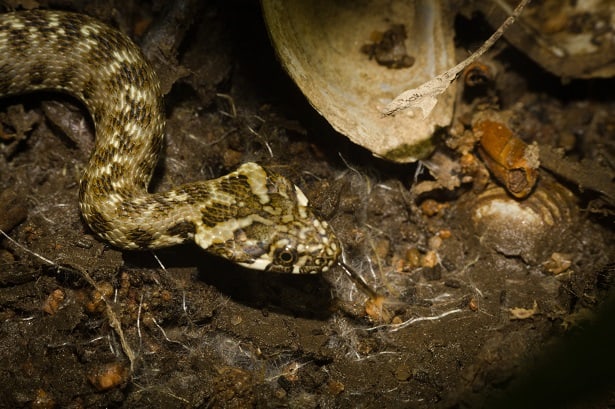
In western Europe, the grass snake (Natrix natrix) is the ubiquitous harmless snake familiar to everyone. Its eastern European cousin is the dice snake (Natrix tessellata), which can swell to vast numbers in certain lakes. The third member, meanwhile, is the viperine watersnake (Natrix maura). This version is the most common in southern Europe, including Spain, Portugal and southern France, with a small bonus colony in North Africa.
Like the other Natrix members, viperine watersnakes are heavily aquatic, sticking to rivers, lakes and canals. Their venom is mild at best, and they almost never bite. However, where this species stands out is in being Europe’s ultimate viper mimic, which explains their name.
Firstly, Natrix maura has a very triangular head, much wider than its grass snake relative. They can even increase the width of this head when greedy bird predators such as short-toed eagles come swooping in, to enhance the intimidation further.
Natrix maura has keeled (rough) scales to touch, like most vipers, and its beige-brown colours are also a perfect mimic. They even coil their bodies up in the same manner as an asp viper. As for their personality, Natrix maura puts on a convincing display, as when cornered, they’ll suddenly “snap” and start attacking the air viciously. In reality, they almost never actually bite, and probably feel terrified the whole time.
| 2 | Particularly common in Spain |
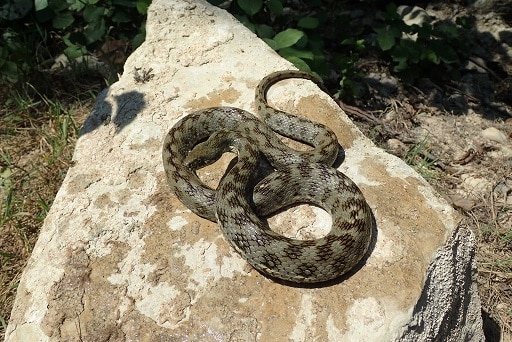
Natrix maura is called a water snake, and water is what they live in. They only avoid two areas: saltwater (the sea) and the fastest currents. However, moderate currents are perfectly acceptable, once they’re fully grown snakes with decent muscular power.
Viperine watersnakes live in lagoons, marshes, rocky streams, lakes, rivers and ponds alike. They also appear in mountain rivers, like the Noguera de Cardós, which flows through the rocky valleys of the Pyrenees. They have no problem with manmade ditches and artificial reservoirs. In fact, it’s believed that the construction of irrigation canals on agricultural land in arid Spain has helped Natrix maura to spread.
Viperine watersnakes inhabit the whole of Iberia (Spain, Portugal). They inhabit the southern half of France, stray into northwest Italy. They’re also plentiful in North Africa, including Morocco, Algeria and Tunisia. Scientists believe that North Africa was Natrix maura’s origin. A study found that those from Morocco and Spain/Portugal diverged 3-3.5 million years ago. However, those in Tunisia were more closely related to the European, so it’s possible that they recolonised North Africa after the original crossing.
| 3 | Impenetrable muddy camouflage |
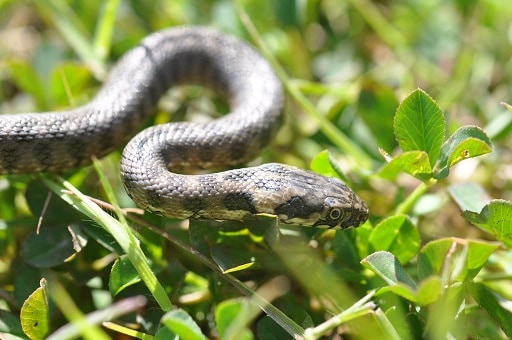
This snake has a huge list of survival strategies in addition to mimicking vipers. Living in rivers, Natrix maura also has hiding at its disposal. They can sink slightly lower into their muddy pools, and remain out of sight until the roving predator moves on. Larger viperine water snakes tend to flee for the opposite shore.
The colder the temperatures, the more likely they are to stay still, relying on camouflage. Viperine watersnakes will sometimes produce a strange snorting sound as well. Like the ball python, they’ll also coil up into a tight ball of coils, with their head at the centre and their tail raised, offering the least valuable part of their body as a distraction. This sometimes results in serious damage; a 2011 study found that in Spain’s Matarranya river, 19.6% of the viperine watersnakes had incomplete tails.
Their options are endless – the one thing they’re incapable of is hurting a human being. Natrix maura has many predators in Spain and North Africa, including purple herons, cattle egrets, grey herons, black-crowned night herons, black kites, red kites, Egyptian vultures, common storks, little owls, and common buzzards.
| 4 | Diet: mainly fish and amphibians |
Lataste’s vipers have cornered the market on mammals, montpellier snakes have stolen all the lizards, so Natrix maura takes the amphibian and fish route instead. They’re specialised enough that they never need to leave their comfortable river homes. They’re also flexible. If a river is swarming with fish schools, then that’s what they’ll eat, while if frogs are hopping all along the shore, then that will be their main sustenance.
For example, a study from the river Jalon in Spain found a diet of 78.4% fish, and 4.2% frogs and toads. But a study from Asturias, northern Spain, found a diet of 44.3% frogs/toads, 10% fish, 14.3% arthropods and 2.9% mammals.
Combining 7 studies from around the Iberian peninsula, the result was 44.8% fish and 14.8% frogs/toads, so there’s a slight bias towards fish. They can be picky occasionally. A study in the Ebro Delta in Catalonia found that their favourite species were the Perez’s frog (Rana perezi) and the common carp. Yet they rejected the mosquito fish, which was one of the most abundant fishes locally.
| 5 | Two hunting strategies |
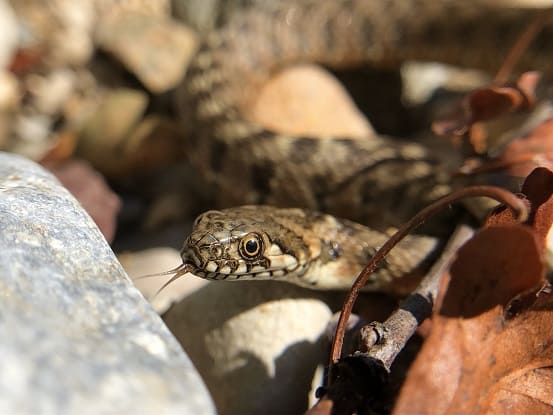
Viperine watersnakes generally swallow their prey by the head, and they have multiple hunting techniques. The first is to attach their body to a rock below the surface, poke their head above water, and wait patiently for a fish to pass. This strategy relies mainly on eyesight. With their tail secured, they can strike flexibly with their head, and they also attach themselves to rocks on the stream’s edge.
The second is to prowl the river surface slowly, like a cruise boat, scanning around patiently for prey. They choose shallow rivers for this exploration strategy, and this strategy mainly relies on chemosensing, flecking their tongue for scent particles.
Natrix maura can be brutal at times. Once their jaws have snapped around a fish, they’ll drag them to the shore while they die. They can also be inventive, using their own tongue as a lure, like the aquatic garter snake of California. In fact, this snake is like a European parallel of the aquatic garter snake in many ways.
| 6 | Not particularly endangered |
Natrix maura isn’t completely dependent on water, and is sometimes spotted relaxing calmly in the sun, usually on rocks. After heavy rains, they’re sometimes found in moist meadows, lurking under a piece of plastic. They’re often run over by screeching car tyres, although the more arid an area, the closer they stick to their precious streams. Unlike the grass snake, Natrix maura has a simple family tree, with no subspecies.
Viperine watersnakes are abundant in Spain, and in Morocco, they’re one of the most common snakes of all. One of their few threats is agricultural pollution. A 1999 study found that viperine watersnakes from Catalonia had several pesticides in their bodies: polychlorinated biphenyls (PCBs), hexachlorobenzene (HCB), and hexachlorocyclohexanes (HCH). Some of these had been banned since the 1970s. They acquire these pesticides by swallowing amphibians and fish, and the mothers pass them onto their children through yolk. The chemicals came from rice fields, abundant on Catalonia’s coast.
| 7 | Always under 1 metre |
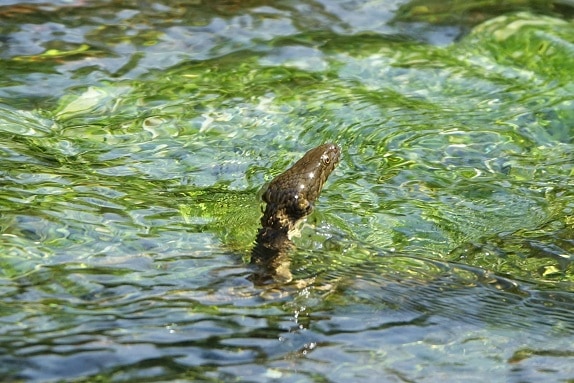
Natrix maura is a medium snake, with a record length of 92.9cm. This was recorded in Rif, Morocco, and the north African enclaves are slightly larger than the European.
In Spain, the largest Natrix maura ever was a female measuring 91.0cm. In Asturia, the largest males and females measured 67.5cm and 78.0cm respectively, in Granada 60.5cm and 87.0cm, and in the Ebro Delta (Catalonia) they were much shorter at 55.8cm and 66.6cm. Female Natrix maura are always slightly longer than males. However, males have more muscular bodies, as they move further each day. Males have a tail making up 23% of their body, whereas in females the proportion is 19%.
At birth, they measure 14.6-22cm. Females lay 3-32 eggs, in late June or early July. The larger the females, the more eggs will be laid. The eggs stick together, and take 40-45 days to hatch. Each egg weighs 3 grams. One interesting thing about Natrix maura is that females store a particularly high amount of body fat for a snake, which gives them a large stash to expend on laying eggs. They’ve been dubbed a “capital breeder”.
| 8 | Swallows particularly large frogs |
Natrix maura is most common below altitudes of 1200 metres. Their altitude record in Spain is 2050 metres in the Sierra Nevada, while in the high Atlas of Morocco they’ve been recorded at 2600 metres.
Naitrx maura normally kicks off the active season in March, but in southern Portugal, they can be spotted throughout the winter. It varies by region, as in France, Natrix maura becomes very active during the summer, while in hot southern Spain, they hunt at night during summer.
The viperine water snake is ambitious in its meals, as they’re able to swallow prey 80% of their own body weight, without bursting or being pierced. Natrix maura preys on 16 out of 29 amphibians in Spain, and that’s only the species recorded. Their confirmed prey include palmate newts, Perez’s frogs, European tree frogs, Iberian painted frogs, and natterjack toads. Like the best river snakes, Natrix maura has large bulging eyes, which are angled upwards for superior vision in water.
| 9 | Rare pattern morphs |
Natrix maura is normally beige-brown, but varies wildly in both its colour and patterns. The most common pattern is a black zigzag extending down its spine from head to toe. This is sometimes surrounded on the flanks by black dots. This zigzag is normally razor sharp, but can also be sloppier and wavier. Likewise, the colour below can be stone grey or sandy beige.
Then there’s a Natrix maura with a completely different design, with horizontal bands instead. This is particularly common in Morocco, and the black bands sometimes have a snowy white core. Natrix maura varies wildly by region. Along the Valvanera river in northern Spain, just 1/212 snakes had this alternative design. In Portugal, it was extremely rare at 14 in 4000, and was only found in the east and south. There’s generally a southward connection, but the banded version also pops up in France, making up 33% in some towns.
Natrix maura has endless different enclaves with weird appearances, and there’s probably some extreme flukes out there, waiting for reptile hunters to find them – maybe a mountain stream where they’re completely yellow.
| 10 | Toads recognise their scent |
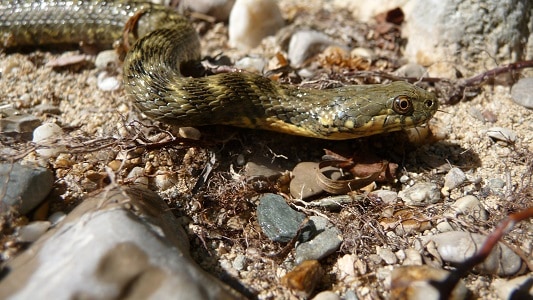
Viperine watersnakes are an invasive species on Mallorca, but unlike the ladder snake, which only landed after 2000, they’ve been there for 2000 years, having been introduced by the Romans. Consequently, the native amphibian on Mallorca has suffered: the Mallorcan midwife toad. There’s just 250-750 breeding pairs of this toad left, thanks to the rampaging snakes. However, they’ve become more inventive in order to survive. The toads have moved to steeper, rocky areas, where Natrix maura cannot cope.
Additionally, a 1998 study hinted that in the last 2000 years , since the Roman empire crumbled, their bodies have begun to adapt. When Natrix maura scents were rubbed onto a towel and placed into an enclosure, the midwife toads recognised them as predators. They were also offered a container scented with tap water (AKA no scent) and they chose this container far more often. To prove that they weren’t simply avoiding any animal scent, the scientists offered them a container with scents from a harmless creature: the African clawed frog. Again, they chose this container over the snake container.
The study used 55 toads and 4 adult viperine watersnakes, to account for variation between individuals. The toads were bred in captivity, and had never encountered Natrix maura in the wild, showing that the avoidance was genetic.
